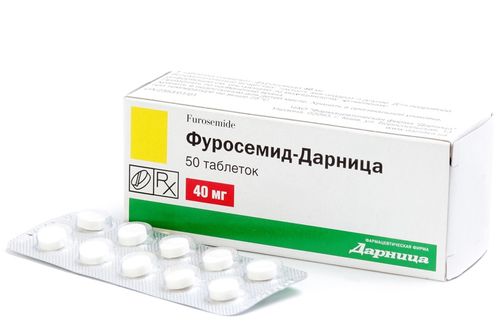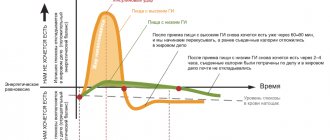Furosemide is a diuretic and is prescribed as a diuretic and decongestant drug.
The drug is produced in the form of tablets for oral administration. Capsules are packaged in contour cells of fifty pieces.
The drug contains one active microelement - furosemide (forty milligrams), as well as a number of additional substances. Whether everyone can drink Furosemide or whether strict adherence to the doctor’s recommendations is necessary, you will learn from this article.
Pharmacodynamics and pharmacokinetics
Furosemide - what is it?
Furosemide is a “loop” diuretic, that is, a diuretic that acts primarily on the thick segment of the ascending limb of the loop of Henle. It is fast-acting. The diuretic effect is pronounced, but short-lived.
How long does it take for Furosemide to work?
After oral administration, the drug begins to act within 20-30 minutes, after infusion into a vein - after 10-15 minutes.
Depending on the characteristics of the body, the effect when using the oral form of Furosemide can last for either 3-4 or 6 hours, while it is most powerfully manifested an hour or two after taking the tablet.
After introducing the solution into a vein, the effect reaches a maximum after half an hour and lasts for 2-8 hours (the more severe the kidney dysfunction , the longer the drug lasts).
Pharmacodynamics
The mechanism of action of the drug is associated with impaired reabsorption of chlorine and sodium ions in the tubules of the nephrons of the kidneys. In addition, Furosemide increases the excretion of magnesium, calcium, phosphates and bicarbonates.
The use of the drug in patients with heart failure leads to a decrease in preload on the heart muscle after 20 minutes.
The hemodynamic effect reaches its maximum severity by the 2nd hour of action of Furosemide, which is due to a decrease in the tone of the veins, a decrease in the volume of circulating blood, as well as the volume of fluid filling the intercellular spaces in organs and tissues.
Reduces blood pressure. The effect develops as a consequence:
- reducing the reaction of the muscles of the vascular walls to a vasoconstrictor (provoking narrowing of blood vessels and a decrease in blood flow in them) effect;
- decrease in BCC;
- increasing the excretion of sodium chloride .
During the period of action of Furosemide, the excretion of Na+ ions increases significantly, but after the cessation of the effect of the drug, the rate of their excretion drops below the initial level (withdrawal or rebound syndrome). Due to this, when administered once a day, it does not have a significant effect on blood pressure and daily Na excretion.
The reason for this effect is the sharp activation of antinatriuretic components of neurohumoral regulation (in particular, renin-angiotensin) in response to massive diuresis.
The drug stimulates the sympathetic and arginine vasopressive systems, reduces the plasma concentration of atriopeptin, and causes vasoconstriction.
Pharmacokinetics
Absorption from the digestive tract is high, bioavailability (proportion of absorbed drug) when taken orally is from 60 to 70%. The binding rate to plasma proteins is 98%.
TSmax when taken orally - 1 hour, when infused into a vein - 0.5 hours.
Furosemide is able to cross the placenta and be excreted in breast milk.
The substance undergoes biotransformation in the liver. Metabolites are secreted into the lumen of the renal tubules.
T1/2 for the oral form of the drug - from one hour to one and a half hours, for parenteral - from half an hour to an hour.
From 60 to 70% of the dose taken orally is excreted by the kidneys, the rest - with feces. When administered into a vein, about 88% of furosemide and its metabolic products are excreted by the kidneys, and about 12% with feces.
Is it possible to lose weight with Furosemide?
Before studying the question of how to take Furosemide for weight loss, you need to find out how effective the drug is. The tablets, in addition to the main component, contain: potato starch, magnesium stearate and milk sugar. A diuretic (a group of diuretics) increases urine production. This process helps draw additional fluid from the tissues, so the medicine is prescribed to people suffering from kidney disease, liver disease, cardiovascular pathologies, and not from excess weight.
Indications for use of Furosemide
Furosemide - what are these tablets for?
Tablets are prescribed for:
- edema, the causes of which are kidney pathologies (including nephrotic syndrome ), stage II-III CHF or liver cirrhosis ;
- manifested as pulmonary edema of acute heart failure ;
- hypertensive crisis (as monotherapy or in combination with other drugs);
- severe forms of arterial hypertension ;
- cerebral edema;
- hypercalcemia;
- eclampsia.
The drug is also used for forced diuresis in case of poisoning with chemicals that are excreted from the body unchanged by the kidneys.
With elevated blood pressure developing against the background of chronic renal failure, furosemide is prescribed if the patient is contraindicated in thiazide diuretics , and also if Clcr does not exceed 30 ml per minute).
Indications for use of Furosemide in ampoules
The annotation for Furosemide in ampoules contains the same indications for use as for the tablet form of the drug.
When administered parenterally, the drug acts faster than when taken orally. Therefore, doctors, when asked “What is the solution for?”, answer that IV administration of Furosemide allows you to quickly reduce pressure (arterial, pulmonary artery, left ventricle) and preload on the heart, which is extremely important in emergency conditions (for example , in hypertensive crisis ).
In the case when the drug is prescribed for nephrotic syndrome , treatment of the underlying disease should come first.
Peculiarities
Before starting therapy, it is important to make sure that the patient does not have stones blocking the ureters. In case of anuria or oliguria of unknown origin, the drug should not be taken orally. What can you drink with Furosemide in such cases?
For preventive purposes, to prevent hypokalemia during drug therapy, people need to take medications containing potassium and potassium-sparing diuretics.
Furosemide contains lactose monohydrate, which must be taken into account when prescribing the medication to patients with congenital intolerance to this substance.
Contraindications for Furosemide
The drug is not prescribed for:
- intolerance to its components;
- ARF, which is accompanied by anuria (if the GFR value does not exceed 3-5 ml/min.);
- urethral stenosis;
- severe liver failure;
- hepatic coma;
- hyperglycemic coma;
- precomatose states;
- obstruction of the urinary tract with stones;
- decompensated stenosis of the mitral valve or aortic orifice;
- conditions in which blood pressure in the right atrium exceeds 10 mmHg. Art.;
- gout;
- hyperuricemia;
- myocardial infarction (in the acute stage);
- arterial hypertension;
- hypertrophic subaortic stenosis;
- systemic lupus erythematosus;
- disorders of water-salt metabolism (hypocalcemia, hypochloremia, hypomagnesemia, etc.);
- pancreatitis;
- digitalis intoxication (intoxication caused by taking cardiac glycosides).
Relative contraindications to the use of Furosemide:
- benign prostatic hyperplasia (BPH);
- diabetes;
- hypoproteinemia (taking the drug increases the risk of developing ototoxicity);
- obliterating cerebral atherosclerosis;
- hepatorenal syndrome;
- hypotension in patients at risk of ischemia (coronary, cerebral or other), which is associated with circulatory failure;
- hypoproteinemia against the background of nephrotic syndrome (possible increased undesirable side effects of Furosemide (especially ototoxicity) and a decrease in its effectiveness).
Patients at risk should be under constant medical supervision. Violation of the blood sugar balance, hypovolemia or dehydration are grounds for reviewing the treatment regimen and, if necessary, temporarily discontinuing the drug.
Diuretics promote the removal of sodium from the body, therefore, in order to avoid the development of hyponatremia, before starting therapy and subsequently throughout the course of using Furosemide, it is necessary to monitor the level of sodium in the patient’s blood (especially in patients with cachexia , cirrhosis , as well as in the elderly).
The use of loop diuretics may cause sudden hypokalemia . Risk groups include:
- aged people;
- patients who are undernourished and/or taking multiple medications at the same time;
- patients diagnosed with cirrhosis with ascites ;
- patients with heart failure .
Hypokalemia increases the cardiotoxicity of digitalis (Digitalis) preparations and the risk of cardiac arrhythmias . In long QT syndrome (congenital or drug-induced), hypokalemia contributes to bradycardia or potentially life-threatening torsade de pointes (TdP ).
In this regard, it is recommended to determine the level of potassium in the patient’s blood as often as possible. The first ionogram should be done within a week after the start of the course.
In diabetics, sugar levels must be systematically monitored throughout the course of treatment.
Additional Information
The drug is not a doping, but it is often used to remove prohibited substances from the body, and also as a means of losing weight in sports where the athlete’s weight is important. In this regard, Furosemide is equated to doping drugs and cannot be used in athletes.
What contraindications does the drug have?
The drug has a huge list of prohibitions on use, so before therapy it is necessary to consult a medical specialist and carefully study the instructions for use. The drug is not recommended for use in the presence of the following conditions:
- Anuria (a condition in which urine does not flow into the bladder).
- Oliguria (decreased amount of urine excreted compared to normal).
- Glomerulonephritis (kidney disease characterized by damage to the glomeruli).
- Hyperuricemia (a disease in which the concentration of uric acid in the blood is higher than the limit values).
- Aortic stenosis (narrowing of the aorta at the valve area, which impedes the flow of blood from the left ventricle).
- Hypertrophic cardiomyopathy (a genetic disease that affects the connective tissue of the right ventricle).
- Pregnancy.
- Lactation (the process of formation, accumulation and periodic excretion of milk).
The drug has a huge number of side effects, so in order not to harm your health by taking other pills, you need to ask your doctor what to drink with Furosemide so as not to harm the body?

Relative prohibitions on taking medication are:
- Low blood pressure.
- Acute infarction (cardiac ischemia, which occurs with the development of necrosis of the myocardium).
- Cardiogenic shock (left ventricular failure, which is characterized by an immediate decrease in myocardial contractility).
- Diabetes mellitus (endocrine diseases that are associated with impaired glucose absorption and develop as a result of absolute or relative).
- Diarrhea (a pathology in which a person experiences frequent, watery bowel movements).
- Pancreatitis (a group of diseases and syndromes in which inflammation of the pancreas occurs).
- Hydronephrosis (persistent progressive disease of the renal pelvis and calyces due to improper outflow of urine into the drainage, which remains in the lumen of the urinary system, leading to gradual degeneration of the renal parenchyma).
Side effects of Furosemide
The following side effects may occur while using the drug:
- cardiovascular disorders , including orthostatic hypotension , arterial hypotension , arrhythmias , tachycardia , collapse ;
- dysfunctions of the nervous system , manifested by dizziness, muscle weakness, headache, tetany , apathy , adynamia , paresthesia , drowsiness, lethargy, weakness, confusion;
- dysfunction of the sensory organs (in particular hearing and vision impairment);
- disorders of the digestive system, including dry mouth, anorexia , cholestatic jaundice , diarrhea/constipation, nausea, vomiting, exacerbation of pancreatitis ;
- disorders of the urogenital tract, including oliguria , interstitial nephritis , acute urinary retention (with BPH), hematuria , impotence ;
- hypersensitivity reactions, including exfoliative dermatitis , urticaria , purpura , necrotizing angiitis , vasculitis , erythema multiforme , chills, pruritus, photosensitivity, fever , anaphylactic shock ;
- disorders of the hematopoietic organ system, including aplastic anemia , thrombocytopenia , leukopenia , agranulocytosis ;
- disorders of water-salt metabolism, including dehydration and, as a consequence, an increased risk of thrombosis/thromboembolism , hypovolemia , hypomagnesemia , hypochloremia , hypokalemia , hypocalcemia , hyponatremia , metabolic acidosis ;
- changes in laboratory parameters, including hypercholesterolemia , hyperglycemia , glucosuria , hyperuricemia .
When Furosemide is administered intravenously, thrombophlebitis , and in newborn infants, renal calcification .
Types of drugs
In general, drugs such as diuretics can be divided into three large groups:
- loop drugs, which are potent drugs that remove salts from the human body, and are also able to cleanse the kidneys of harmful compounds accumulated there (such drugs are “Torasemide” and “Furosemide”);
- thiazide diuretics, which differ from the previous version by a more moderate effect on the body (this group includes diuretics for weight loss such as Hydrochlorothiazide and Indapamide);
- diuretics for weight loss of mild effect, which, when exposed to the body, can retain potassium (such drugs are “Amiloride” and “Veroshpiron”).
Whatever diuretic you choose for weight loss, you must follow general recommendations when taking them. These recommendations are:
- drink a very large amount of water during intake;
- take vitamin complexes and introduce more potassium-rich foods into your diet;
- adhere to a proper nutrition system, as well as give your body physical activity (moderate, do not overdo it and create a load on your body in addition to the existing one);
- take diuretics for weight loss for a short time, no more than a few days.
Instructions for use of Furosemide
How to take Furosemide for edema?
Diuretic tablets are taken orally. The doctor selects the dose individually depending on the indications and characteristics of the course of the disease.
An adult with edema that has developed against the background of pathologies of the liver, kidneys or heart is prescribed to take ½-1 tablet/day if the condition is assessed as moderate. In severe cases, the doctor may recommend taking 2-3 tablets. 1.r./day or 3-4 tablets. in 2 doses.
How to lower blood pressure with Furosemide?
To reduce high blood pressure in patients with chronic renal failure, the drug is used in combination with antagonists of the renin-angiotensin system. The recommended dose varies from 20 to 120 mg/day. (½-3 tablets/day). The medicine is taken in one or two doses.
Furosemide for weight loss
Some women use the properties of the drug for weight loss. Taking Furosemide tablets (Furosemide Sopharma) really allows you to get rid of several kilograms, but this weight loss can hardly be called weight loss, since the drug does not remove excess fat in problem areas, but only removes water from the body.
Instructions for use of Furosemide in ampoules
The preferred method of administering the solution is a slow intravenous injection (performed over 1-2 minutes).
The drug is administered into the muscle in exceptional cases when oral or intravenous administration is not possible. Contraindications for intramuscular administration of Furosemide are acute conditions (for example, pulmonary edema ).
Taking into account the clinical condition of the patient, it is recommended to transfer Furosemide from parenteral to oral administration as soon as possible.
The question of the duration of treatment is decided taking into account the nature of the disease and the severity of symptoms. The manufacturer recommends using the lowest possible dose at which the therapeutic effect will be maintained.
For edematous syndrome in adults and adolescents over 15 years of age, treatment begins with the injection of 20-40 mg of Furosemide into a vein (in exceptional cases, into a muscle).
In the absence of a diuretic effect, the drug is continued to be administered every 2 hours at a dose increased by 50%. Treatment according to this regimen is continued until adequate diuresis is achieved.
A dose exceeding 80 mg should be administered into a vein by drip. The rate of administration should not be more than 4 mg/min. The maximum permissible dose is 600 mg/day.
In case of poisoning, to maintain forced diuresis, the patient should be administered from 20 to 40 mg of the drug, having previously dissolved the required dose in an infusion solution of electrolytes. Further treatment is carried out depending on the volume of diuresis. It is mandatory to replace the salts and fluids lost by the body.
The initial dose for hypertensive crisis is 20-40 mg. It is subsequently adjusted based on clinical response.
Furosemide injections and tablets: instructions for use in children
In pediatrics, the dose is selected depending on the patient’s weight. Furosemide tablets are given to a child at a rate of 1-2 mg/kg/day. The dose can be taken in one dose or divided into two doses.
Only the attending physician can answer questions about how often you can take the drug in a given case, as well as how long the course of treatment will be. The only clear recommendations are as to what to take Furosemide with: in addition to diuretics, you should definitely take potassium supplements.
The medicine is administered intravenously to children under 15 years of age at a dose of 0.5-1.5 mg/kg/day.
Furosemide tablets: what are they used for in veterinary medicine?
Why is Furasemide Sopharma used in veterinary medicine? In veterinary practice, Furosemide and similar drugs are used as part of complex therapy for the treatment of heart pathologies in dogs.
The use of diuretics allows you to remove fluid that accumulates around the lungs, abdominal or chest cavity, thereby reducing the load on the heart.
For dogs, the dosage of Furosemide depends on the weight of the animal. As a rule, the drug is given 2 times a day at a rate of 2 mg/kg. As an addition to treatment, it is recommended to give your dog bananas daily (one per day) to compensate for potassium losses.
Storage conditions
The drug is dispensed from pharmacies strictly according to a doctor's prescription. Furosemide should be kept in a place protected from children, at a temperature of no more than plus twenty-five degrees. The shelf life of the medicine is forty-eight months. The cost varies from 15 to 25 rubles.
Furosemide for weight loss is a very popular method that allows you to get rid of extra pounds in a couple of days. The number of drugs that are used for these purposes is huge, but this diuretic drug is considered the most accessible and well-known. Furosemide has been used in medical practice for a long time, so all its positive aspects and side effects have been well studied. According to reviews from those losing weight, Furosemide is excellent at helping to lose excess weight when it appears as a result of fluid retention in the body.
Overdose
Symptoms of Furosemide overdose:
- a sharp drop in blood pressure;
- hypovolemia;
- dehydration;
- collapse;
- hemoconcentration;
- shock;
- arrhythmias (including atrioventricular block and ventricular fibrillation);
- thrombosis;
- thromboembolism;
- confusion;
- drowsiness;
- acute renal failure with anuria ;
- apathy;
- flaccid paralysis
To normalize the patient’s condition, measures are prescribed aimed at correcting CSR and water-salt metabolism, replenishing the deficit of blood volume. Further treatment is symptomatic.
Furosemide does not have a specific antidote.
Effect on the body

The scheme by which diuretics work when they enter the body is simple:
- almost instantaneous removal of fluid (from half an hour to 6 hours) promotes rapid weight loss;
- due to the powerful effect on electrolyte metabolism, metabolism accelerates;
- decreased appetite: there is no time to think about food, when every hour the body demands to get rid of a new portion of excess liquid;
- As practice shows, instant results improve mood, which affects motivation.
I took a pill today, ran to the toilet - and tomorrow the scales showed the first result (it will be different, depending on the drug chosen and the initial data). After what you see, your mood rises, you want to improve the effect, and your hand reaches out for a new portion of the diuretic, regardless of the dosages indicated in the instructions. And after a few days, the realization comes that there was no need to do this, because uncontrolled use of diuretics leads to a lot of side effects and complications.
Therefore, experts strongly do not recommend taking diuretics as the main method of losing weight. If such a need arises, you need to strictly follow the instructions and at the first problems or doubts, seek help from a doctor.
A natural alternative. Nutritionists advise, whenever possible, to replace medications with natural remedies: tea, coffee, parsley, watermelon, melon, oats, tomatoes, celery, etc.
Interaction
Furosemide increases the concentration and toxicity (in particular, oto- and nephrotoxicity) of Ethacrynic acid , Aminoglycosides , Cephalosporins , Cisplatin , Chloramphenicol , Amphotericin B.
Enhances the therapeutic effectiveness of Theophylline and Dazoxide , reduces the effectiveness of Allopurine and hypoglycemic drugs .
Reduces the rate of renal excretion of Li+ drugs from the blood, thereby increasing the likelihood of intoxication with them.
Strengthens the neuromuscular blockade caused by non-depolarizing relaxants (peripheral relaxants) and the effect of antihypertensive drugs , weakens the effect of non-depolarizing relaxants .
In combination with pressor amines, there is a mutual decrease in the effectiveness of the drugs; with Amphotericin B and GCS, the risk of developing hypokalemia .
Use in combination with cardiac glycosides (CGs) may provoke the development of the latter's inherent toxic effects due to a decrease in the level of potassium in the blood (for low- and high-polarity CGs) and an extension of the half-life (for low-polarity CGs).
Drugs that block tubular secretion help increase the serum concentration of furosemide.
Sucralfate and NSAIDs reduce the diuretic effect of the drug due to suppression of Pg synthesis, changes in plasma renin and aldosterone .
The use of high doses of salicylates during treatment with the drug increases the risk of their toxicity, which is caused by competitive renal excretion of the drugs.
The Furosemide solution injected into a vein has a slightly alkaline reaction, so it is contraindicated to mix it with drugs whose pH is below 5.5.
Not recommended combinations for the solution
Administration of Furosemide into a vein within 24 hours after chloral hydrate can provoke:
- nausea;
- flushes of blood;
- anxiety;
- increased sweating;
- increased blood pressure;
- tachycardia.
The use of furosemide with ototoxic drugs (for example, aminoglycosides ) can cause irreversible hearing damage . This combination can only be used for health reasons.
Can natural diuretics compete with tablets?
You can lose weight not only with pharmaceutical diuretics: some diuretic herbal products for weight loss cope with this task perfectly. You can replace harmful medications with these natural remedies:
- medicinal plants. Birch leaves, milk thistle, horsetail, parsley, dandelion greens, nettle, horsetail, St. John's wort, alfalfa, and bearberry leaves are suitable for such purposes. A decoction should be prepared from these plants - 1 tbsp per 500 ml of boiling water. l. vegetable raw materials. Filter. Drink the infusion 2 r. per day, 250 ml chilled;
- fruits (pear, mango, coconut);
- berries (watermelon, melon, grapes, strawberries);
- vegetables (cabbage, zucchini, beans, carrots, celery, pumpkin, asparagus, eggplant, peas, spinach, beets).

These diuretics, used for weight loss at home, will only help you lose a little weight, but will improve your overall health. But getting carried away with them is also unwise: long-term use of even natural diuretics can cause dehydration.
special instructions
During the entire course of treatment, it is recommended to avoid activities that potentially threaten life and health, which require rapid psychomotor reactions and increased attention.
During the course of treatment, you should periodically do a blood ionogram, as well as monitor blood pressure levels, blood pressure, uric acid, creatinine, residual nitrogen, and liver function. If necessary, the treatment regimen is revised taking into account these indicators.
When using high doses of Furosemide, it is not recommended to limit the consumption of table salt, which is associated with the risk of developing metabolic acidosis and hyponatremia .
In patients with BPH, hydronephrosis , narrowing of the ureters , and in patients who are unconscious, urinary output should be monitored due to the possibility of acute urinary retention.
The tablet form of the drug is contraindicated for people with glucose/galactose malabsorption syndrome, congenital galactosemia, hypolactasia .
Is it possible to drive a car while using the drug?
While taking tablets, you must refrain from driving vehicles and operating equipment that requires attention. This is due to possible dizziness and a sharp drop in blood pressure in a person after taking the medicine. How often can you drink Furosemide according to the instructions?
Between doses of the medicine it is necessary to take a break with a time interval of six hours. If necessary, furosemide therapy can be combined with antihypertensive medications.
How to replace Furosemide?
Analogues of Furosemide in tablets: Furosemide Sopharma , Lasix .
Analogues of the parenteral form of the drug: Furosemide-Darnitsa , Furosemide-Vial , Lasix .
Drugs belonging to the same pharmacological subgroup with Furosemide: Bufenox , Britomar , Diuver , Trigrim , Torasemide .
What is better - Lasix or Furosemide?
Lasix is one of the trade names for furosemide. The drug is produced by the Indian company Sanofi India Ltd. and, like its analogue, has two dosage forms: a one-percent d/i solution and 40 mg tablets.
Thus, when choosing one or another remedy, one should be guided by subjective feelings. The advantage of Furosemide is its lower price.
History of the creation of diuretics
- For the first time, people started talking about diuretics as effective medications in the 50s of the last century. Research on substances began with the synthesis of chlorothiazide, which served as a serious impetus for the further development and study of diuretic substances.
- Furosemide was created in 1963. It almost immediately found application in the treatment of many serious diseases of various natures. For more than 50 years, this medication has been the main effective remedy in the fight against edematous syndrome. However, experiments and research to obtain a safer composition did not stop.
- In the 80s, an analogue of Furosemide, Torasemide, appeared. Polish pharmacists synthesized a substance - a loop diuretic, which found its use only in the 90s. The analogue is a sulfonylurea derivative.
Furosemide for weight loss
There is a lot of advice on the Internet regarding the use of diuretics for weight loss. One of the most accessible drugs in this group is Furosemide.
What does the medicine help with? According to the instructions, Furosemide is used for ascites , edema syndrome , and hypertension . Thus, the manufacturer does not report anything regarding the possibility of using diet pills.
However, many women note that with the help of this remedy they were able to quickly lose several kilograms (in some cases, up to 3 kg per night). However, such weight loss cannot be regarded as weight loss: the action of the drug is aimed at removing excess fluid, and not at all at breaking down fat.
Why is Furosemide dangerous?
The use of diuretics for weight loss can cause serious health problems, since by removing water, these drugs also upset the balance of electrolytes in the body. one of the most common side effects is hypokalemia .
Potassium deficiency, in turn, leads to muscle cramps, weakness, blurred vision, sweating, loss of appetite, nausea, and dizziness.
A very dangerous side effect is arrhythmia . SOLVD studies have shown that treatment with loop diuretics is associated with increased mortality among patients. At the same time, both the rates of general and cardiovascular mortality and the number of sudden deaths are increasing.
Another danger that can result from the uncontrolled use of diuretics for weight loss is impaired kidney function. Moreover, it may take more than one month to restore the function of the kidneys and lymphatic system.
How to take Furosemide for weight loss?
To remove a few extra pounds, women usually take 2-3 (no more!) Furosemide tablets during the day with an interval of three hours between doses, and then 2 more tablets at night.
You can repeat the one-day course no earlier than after 2-3 days.
Furosemide and Asparkam for weight loss
Since one of the side effects of Furosemide is hypokalemia , it is very important during the period of use of this drug to adhere to a certain diet (this means eating foods high in potassium) or additionally take medications that can minimize the side effects inherent in diuretics .
As a rule, Furosemide is recommended to be taken in combination with Asparkam (Panangin) . What is Asparkam ? This is a drug that is used as an additional source of potassium and magnesium. The medicine has a harmless composition, which eliminates the possibility of its unwanted interaction with Furosemide.
recommendations on how to take diuretics with Asparkam . Asparkam tablets , according to the manufacturer's instructions, are taken 3-6 pieces per day, dividing the indicated dose into three doses.
How often can you take Furosemide for weight loss?
Optimally - never. As a last resort, the drug can be used as an emergency remedy when swelling is urgently needed.
Reviews from women who tried to lose weight on Furosemide indicate that taking more than 2 tablets per week is always accompanied by side effects. In addition, another problem often arises - how to “get off” the drug.
What other negative effects can Furosemide cause?
- Reactive pancreatitis.
- Oliguria (decreased amount of urine excreted compared to normal).
- Hematuria (a medical term meaning the presence of blood in the urine in excess of the physiological norm).
- Impotence (erectile dysfunction in which the volume of a man's penis).
- Erythema (severe redness of the skin caused by dilation of capillaries).
- Vasculitis (a group of diseases based on immunopathological inflammation of blood vessels).
- Quincke's edema (a reaction to various biological and chemical factors, often of an allergic nature).
- Nettle rash (skin disease, mainly dermatitis of allergic etiology, which is characterized by the sudden appearance of blisters).
- Dermatitis.
- Anaphylaxis.
- Lyell's syndrome.
- Decrease in the number of leukocytes per unit volume of blood.
- A decrease in platelet count below the standard.
- Hypovolemia.
What to drink with Furosemide so as not to provoke a side effect? You can take Asparkam with the drug.
Is it possible to drink Furosemide during pregnancy?
When asked whether pregnant women can take diuretics , most doctors answer that modern medicine offers much safer methods of gestosis and preeclampsia
That is, Furosemide during pregnancy can only be used as an emergency aid, for the shortest possible course and only on condition that the woman is under strict medical supervision.
According to the FDA classification, the drug belongs to category C.
Despite all the contraindications, women quite often leave reviews on forums about the use of Furosemide during pregnancy.
Almost all of them note that the drug really quickly removed excess fluid from the body, but it also caused unpleasant side effects (for example, leg cramps).
Therefore, all mothers are unanimous in their opinion - Furosemide can be taken only according to strict indications and only in a situation without alternative.
Use during lactation
Furosemide penetrates into milk and is capable of suppressing lactation, so its use in nursing women is possible only if the child is transferred to artificial feeding during the mother's treatment.
Can the medicine be used during pregnancy?

In the first three months, Furosemide tablets are not recommended for pregnant women, since at this stage the internal organs of the fetus are formed, and the effect of drugs on the maternal body is undesirable.
In subsequent trimesters, the drug can be used by patients only in situations where there are serious problems. The doctor carefully evaluates the likely risks to the fetus versus the benefits to the mother. The medicine easily crosses the placental barrier, but clinical studies did not reveal any effect of Furosemide on the child.
The medication is excreted in milk and can enter the baby’s body. If it is necessary to treat with Furosemide, a nursing mother must stop lactation so as not to harm the baby.

Reviews of Furosemide
Furasemide is one of the most effective diuretics with fast and short action.
Reviews from doctors confirm the fact that the drug plays a key role in the treatment of edema syndrome in patients with heart failure , since loop diuretics most effectively block the reabsorption of Na+ ions in the ascending segment of the loop of Henle. At the same time, Furosemide retains its activity even in patients with chronic renal failure (including at the terminal stage of the disease).
However, the use of loop diuretics may cause irreversible damage to the renal tubules, especially when the drug is prescribed in high doses.
A parallel increase in the delivery of Na+ ions to the distal nephron, where loop diuretics , leads to sodium overload and structural damage to these parts of the nephron with the development of hyperplasia and hypertrophy .
In addition, after the end of the drug’s action, Na+ reabsorption increases significantly and, as a result, a “ricochet” effect develops, manifested by an increase in post-diuretic reabsorption.
Reviews left by patients allow us to conclude that the medicine helps well against edema and is indispensable for hypertensive patients. The disadvantages of the drug are usually side effects, contraindications and the fact that it is addictive.
Another category of reviews is reviews of Furosemide for weight loss. Despite the fact that the drug really allows you to quickly reduce weight by 3-5 kg, both doctors and those losing weight do not recommend using it for weight loss. This is due to the fact that the drug does not remove excess fat, but only removes water (and with it substances necessary for the body to function normally).
Thus, given that Furosemide is a very powerful drug, it can only be used taking into account contraindications, not exceeding the prescribed dose and only under the supervision of a doctor (especially during pregnancy). Also, you should not take it for other purposes (for example, for cystitis ).
When treating with diuretics, a very important question is what to take the drug with. It is optimal to supplement therapy by eating potassium-rich foods or taking potassium supplements.
Frequently asked questions and their answers
Below are answers to questions that patients often have about the use of the diuretic drug furosemide.
Is it possible to drink furosemide every day?
Furosemide is taken every day as prescribed by a doctor for people whose liver cirrhosis is complicated by ascites - an accumulation of fluid in the abdominal cavity. Previously, this daily medication was prescribed to patients with heart failure and hypertension. Now the new drug torasemide (Diuver) is replacing furosemide in the treatment of heart failure. Why torasemide is better is described in detail below. If you take furosemide every day for heart failure, discuss with your doctor whether it should be replaced with torasemide.
If you have hypertension, it is better not to take furosemide daily, like any other loop diuretics. These medications cause too many side effects. Use blood pressure pills that act more gently. Consult your doctor to find a medication regimen that will bring your hypertension under control without worsening your health and test results. Some people take furosemide occasionally when they have a hypertensive crisis. It is better instead to properly treat hypertension so that there are no pressure surges at all. Do not take furosemide daily for weight loss or swelling! This can cause terrible side effects. They are vividly described on many websites and forums in Russian.
Can I take this medicine at night?
As a rule, doctors prescribe taking furosemide in the morning or afternoon, and not at night, so that the patient does not have to get up to go to the toilet too often at night. For some reason, your doctor may tell you to take furosemide at night. In this case, follow his instructions. Many people have voluntarily tried taking this diuretic medicine at night to avoid swelling and look good the next morning. Russian-language sites and forums are replete with terrible descriptions of the side effects that such self-medication leads to. The authors of numerous frightening stories about the side effects of furosemide are not exaggerating at all.
Are furosemide and alcohol compatible?
Alcohol increases the frequency and severity of furosemide side effects. If you use a diuretic drug and alcohol at the same time, your blood pressure may drop too low. Symptoms of this: headache, dizziness, fainting, palpitations. Furosemide often causes orthostatic hypotension - dizziness when standing up suddenly from a sitting or lying position. Alcohol may increase this side effect. Alcohol dehydrates the body and removes beneficial minerals, just like diuretics. Furosemide should be taken only for severe illnesses in which alcohol consumption is completely prohibited. Even a small dose of alcohol will be harmful to you. For mild illnesses that allow moderate alcohol consumption, try to replace the loop diuretic with a more gentle drug or avoid taking medications altogether.
How to take furosemide and Asparkam together?
Take furosemide and Asparkam together only as prescribed by your doctor, and have regular blood tests to check your potassium levels. Furosemide deprives the body of a valuable electrolyte - potassium. Asparkam and Panangin tablets replenish potassium reserves. Discuss with your doctor whether you need to take furosemide and Asparkam at the same time. Don't do this on your own initiative. Asparkam has contraindications. Please read them before using this product. Take both medications in the dosages prescribed by your doctor, as many times a day as your doctor prescribes.
Why doesn't furosemide work? The patient's swelling does not decrease.
Furosemide is only a temporary solution to the problem of edema. It does not affect their cause, and sometimes even worsens it. If the cause cannot be eliminated, then over time even potent diuretics stop working. Perhaps the patient's kidneys have become so bad that the body has stopped responding to the diuretic medicine. In such situations, you cannot voluntarily increase the dose of furosemide or change it to another diuretic. Talk to your doctor about what to do.
How to restore kidney function after treatment with furosemide?
To find out how furosemide affected the kidneys, ask about the glomerular filtration rate (creatinine clearance), and then take a blood test for creatinine. Learn and follow the rules for preparing for this test to ensure accurate results. Creatinine clearance is the main indicator by which you can judge whether a person's kidneys are working well.
It is rare that unauthorized use of one or more furosemide tablets will cause permanent kidney damage. Most likely, your health and kidney function will return to normal soon after you stop taking the diuretic medication. If you have experienced unpleasant side effects, this will serve as a lesson: you should not take strong drugs on your own initiative.
Unfortunately, for people who develop kidney failure, there is no easy solution to the problem. Furosemide damages the kidneys. But if the swelling is so severe that it is impossible to tolerate it, then you have to use this remedy, despite the side effects. Follow your doctor's diet and medication instructions to delay the point at which your kidneys fail completely. There is no effective alternative treatment for kidney failure. Diabetes patients should study the article “Diet for kidneys in diabetes”.
Torsemide or furosemide: which is better?
Torsemide is better than furosemide for the treatment of heart failure. Both of these medications are loop diuretics. Torsemide was invented 20 years later than furosemide, in 1988. In Russian-speaking countries, the first drug torasemide was registered in 2006.
Furosemide and torasemide: comparison
| Furosemide | Torasemide | |
| Poor absorption when taken with food | Yes | No |
| Excretion from the body | 50/50 kidneys and liver | 80% - liver, 20% - kidneys |
| Potassium deficiency in the body in patients | Often | Rarely |
Torsemide acts more gradually and longer than furosemide and is considered a safer drug. A possible side effect of loop diuretics is a decrease in potassium levels in the blood of patients. Torsemide causes it less frequently. Sometimes torasemide is prescribed to patients in the later stages of renal failure, when furosemide can no longer be taken. After the dose of furosemide has worn off, urinary salt excretion may be significantly reduced due to the rebound effect. Torsemide does not have this problem.
If you are taking furosemide for heart failure edema, talk to your doctor about changing it to torasemide (Diuver). Authors of articles in medical journals claim that in patients with hypertension, torasemide does not affect blood sugar and uric acid levels, unlike furosemide. Don't trust this information too much. People with high blood pressure may benefit from taking safer medications daily than the loop diuretics furosemide and torsemide.
Medicines containing the active ingredient Torasemide:
- Diuver
- Britomar
- Trigrim
Torsemide appears to be as good as furosemide for treating fluid accumulation in the abdomen (ascites) caused by cirrhosis of the liver. See, for example, the article “Torasemide versus furosemide in cirrhosis: a long-term, double-blind, randomized clinical study” by Fiaccadori F., Pedretti G., Pasetti G. et al in the journal “The Clinical Investigator” for 1993. However, furosemide is still prescribed many times more often than torasemide for severe liver diseases. Typically, with liver cirrhosis, patients take a loop diuretic and Veroshpiron (spironolactone) simultaneously.
Furosemide or Veroshpiron: which is better? Can it be taken together?
Many patients are interested in which medicine is better: furosemide or Veroshpiron? You can’t pose the question like that, because these are completely different medicines. They are prescribed for different purposes. Therefore, it cannot be said that furosemide is better than Veroshpiron, or vice versa. Sometimes patients have to take both of these drugs at the same time. Furosemide is a powerful diuretic medicine that belongs to the loop diuretics. It stimulates the removal of fluid and salt from the body. Its effect is quick and strong, although not long lasting. While the patient's kidneys can still respond to diuretics, this medicine is good for edema. Veroshpiron has a weak diuretic effect. But it improves the results of treatment with furosemide and reduces the risk of a side effect - potassium deficiency in the body.
The drug Diuver (torasemide) and its analogues have replaced furosemide in the treatment of heart failure. Because torasemide works better and causes fewer side effects. However, furosemide remains a popular treatment for ascites (a build-up of fluid in the abdomen) caused by cirrhosis of the liver. For severe liver diseases, patients are often prescribed furosemide and Veroshpiron together. Usually they start with a dosage of 100 mg of Veroshpiron and 40 mg of furosemide per day. If this dosage does not help enough, it is increased after 3-5 days. At the same time, the ratio of Veroshpiron and furosemide is maintained at 100:40 to maintain optimal potassium levels in the blood.
How much do the tablets cost and how much can you buy Furosemide solution for?
The price of Furosemide in injection form in Ukraine is from 14 UAH. The price of Furosemide in tablets is from 5.5 UAH.
The price of Furosemide diuretic tablets in Russian pharmacies is from 15 rubles. The price of ampoules is from 22.5 rubles.
- Online pharmacies in RussiaRussia
- Online pharmacies in UkraineUkraine
- Online pharmacies in KazakhstanKazakhstan
ZdravCity
- Furosemide tablets 40 mg 50 pcs. Ozone LLC
34 rub. order - Furosemide tablets 40 mg 50 pcs. Borisov plantBorisov plant
24 RUR order
- Furosemide tab. 40 mg No. 56 Renewal JSC "PFK Obnovleniye" RU
43 RUR order
Pharmacy Dialogue
- Furosemide (tab. 40 mg No. 50) Ozone LLC
30 rub. order
- Furosemide ampoules 1% 2ml No. 10DHF JSC
83 RUR order
- Furosemide tablets 40 mg No. 50BZMP
25 rub. order
show more
Pharmacy24
- Furosemide-Darnitsa 1% 2 ml No. 10 solution for injection PrAT" Pharmaceutical company "Darnitsa", Ukraine
19 UAH. order - Furosemide-Darnitsa 0.04 No. 50 tablets PrAT” Pharmaceutical company “Darnitsa”, Ukraine
8 UAH order
- Furosemide 4 mg No. 50 tablets PAT "Kievmedpreparat", Ukraine
13 UAH order
- Furosemide 40 mg No. 20 tablets AT "Sopharma", Bulgaria
13 UAH order
- Furosemide 40 mg No. 50 tablets PAT NEC "Borshchagivsky HFZ", m.Kiev/TOV "Agrofarm", Kiev region.
7 UAH order
PaniPharmacy
- Furosemide tablets Furosemide tablets 40 mg No. 50 Ukraine, OZ GNTsLS LLC
9 UAH order
- Furosemide tablets Furosemide tablets. 40 mg No. 20 Bulgaria, Sopharma
14 UAH order
- Furosemide ampoule Furosemide solution d/in. 1% amp. 2ml No. 10 Ukraine, Darnitsa ChAO
22 UAH order
- Furosemide tablets Furosemide tablets 0.04g No. 50 Ukraine, Kievmedpreparat OJSC
15 UAH order
- Furosemide tablets Furosemide tablets 40 mg No. 50 Ukraine, Darnitsa ChAO
9 UAH order
show more
Release form
Today, Furosemide can be bought at pharmacies in two forms:
- Tablets with a pronounced diuretic effect. One tablet contains 40 mg of active ingredient. The composition also contains additional/auxiliary components: milk sugar, gelatin, potato starch, silicon dioxide, etc. The pharmacy offers packages No. 20 and 50.
- Injection. There are 10 milliliters of solution per milliliter of active substance. Auxiliary components in the drug: sodium chloride, hydroxide and special water for injection. One ampoule contains 2 milliliters of Furosemide. The package contains 10 small vials.
Why the drug is dangerous: unpleasant consequences
After stopping the diuretic, the patient's swelling may worsen. This may happen for one of the following reasons:
- A consequence of a disease treated with Furosemide. In this case, you will need to consult your doctor with subsequent correction of the pathology.
- Symptom of drug addiction.
With the furosemide-dependent effect, everything is a little more complicated. You will need to take mineral medications containing potassium and magnesium, but it is better to consume liquid in small quantities. Use herbal remedies as diuretics. It is advisable to drink no later than 4 o'clock in the afternoon, and take the last meal before 6 o'clock in the evening. These recommendations will have to be followed for 30 days or more.
In order to prevent hypokalemia, you need to introduce foods high in potassium into your diet - nuts, dried apricots, raisins, beans, peas and other legumes, kale, potatoes. At the same time, it is recommended to take potassium supplements.
To compensate for magnesium deficiency, you will need to take chloride or magnesium gluconate. Sodium chloride therapy for low sodium levels in the blood is carried out carefully, since salt retains fluid in the body.
Opinions of patients and doctors

Below are real reviews from doctors and patients. Let's find out what opinion has developed about the diuretic in medical practice and among those who used the drug for any reason.
Arkady Pretrovich, doctor:
Of course, the diuretic effect is very sharp, especially for the first time. A big mistake when treating chronic heart failure with symptoms of swelling is to expel fluid from the body several times a week. I believe that it should be taken every day, in the morning, and in the dosage prescribed by the doctor.
I do not recommend taking Furosemide in tablet form for long-term treatment of hypertension. For treatment, you can use other diuretics that help lower blood pressure, for example, Torsemide. Many people do not know the best about the drug, which entails a lot of side effects and serious consequences. However, if you use drugs that retain potassium in the body together with Furosemide, then everything will be fine. The most important thing is not to self-medicate, but to seek help from an experienced doctor.
Petr Maksimovich, 49 years old
Good pills for those with hypertension. I drink according to the regimen chosen by the doctor. The medicine generally removes swelling, but sometimes not immediately and not always, then the dosage has to be increased. In combination with Lokren, it remarkably normalizes blood pressure and relieves swelling. It helps me.
Irina Petrovna, 43 years old
I have never considered Furosemide for weight loss purposes. I don't understand those who use it specifically for this. After all, in addition to liquid, calcium and magnesium are washed out. If these minerals are not replenished, then continuous problems begin: teeth crumble, hair falls out, nails break, severe muscle cramps begin, and insomnia is definitely guaranteed! People, think before you use the drug!
Sofia, 30 years old
From my own experience, I want to warn girls who are trying to get rid of excess weight or simply swelling using this remedy. So I, too, decided to use it to relieve swelling for a while, but in the end I got hooked on a diuretic, and each time I had to increase the dosage. In addition, she developed dehydration and heart problems. I had to see a doctor for help. I ask everyone to treat the drug with extreme caution; it’s better not to try it at all.
Marina Yurievna, 53 years old
There was a period when I started to swell a lot. I used to drink a cup of water before going to bed, so in the morning there’s some kind of guard! The swelling did not go away on its own, so I had to consult a doctor. That's when I learned about Furosemide. I only had to take 1 tablet, but at the same time I was also prescribed a potassium-containing drug, I don’t remember the name. There were no side effects. I can’t say anything bad about the diuretic, the main thing is to do everything correctly.
Georgy Ivanovich, cardiologist
It is unlikely that women think about the dangers of diuretics for weight loss when they strive to quickly achieve an ideal figure. It seems to them that a couple of tablets cannot disable the body. In fact, everything is somewhat different. Not everyone knows exactly how to take Furosemide for weight loss? Units! But this is one of the most powerful diuretics, which anyone can buy at the nearest pharmacy, and I would have long ago banned the sale of it without a prescription. The fact is that the effect of a diuretic on the heart is very great, and not for the better. Uncontrolled dosage and lack of idea about how much you can drink the drug over time lead to disastrous results. First, a rapid heartbeat appears, then shortness of breath increases, and then women run to the doctor, complaining of sleep disturbances and dizziness. I have had few such patients, fortunately, but I urge everyone who is looking for a good method of losing weight to first of all think not about beauty, but about health.
Margarita Yuryevna, nutritionist
More and more often I hear from women about losing weight on the well-known diuretic - Furosemide. Yes, he shows the results that are shown by photos of fit figures on the Internet. But the risk is also hard to ignore. In addition to the side effects presented in the instructions for use of Furosemide, there is one more thing - the body’s addiction. If you lose weight with the help of a drug for a long time, your internal organs and systems stop working at full capacity, knowing that the pills will do everything for them. The body seems to forget about the need to remove fluid, which affects the functioning of the kidneys and lymphatic system. In addition, when using diuretics, our body leaves useful substances and vitamins, the level of which can be quite difficult to restore even with proper nutrition and taking special medications.
I am definitely against losing weight on diuretics. I can only recommend them to those who suffer from increased swelling, and only after consulting a specialist and undergoing the necessary examination. It is better to choose a good diet for yourself, give up bad habits and become a regular at the sports complex. Then the problem of excess weight will disappear.
Efficacy and risks of taking pills
The use of the drug for weight loss can provoke the development of dysfunction of the excretory system and kidneys. With frequent stimulation of the organs responsible for removing excess fluid, the body begins to forget the natural mechanisms of water exchange and removal of excess biological fluid.

If you take the pills for a long time, then after stopping the drug the swelling will return and become more pronounced. It takes several months for renal function and the lymphatic system to normalize, and some functions may not be restored at all.
Also, with prolonged use, addiction to the drug may develop. There will be deterioration in the general condition due to significant loss of fluid. When taking pills for a long time, increased fatigue, digestive disorders, apathy and depression develop. The process of weaning off the drug is long and difficult.
Don't miss the most popular article in the section: Morning exercises for those over 40, 50. Gymnastics exercises for weight loss, video lessons.
Why the drug is dangerous: unpleasant consequences

Due to long-term use of the drug, a dose-dependent effect appears in humans. In more detail, an increase in the volume of urine occurs due to the intake of different amounts of medication associated with the pathology and personal characteristics of the patient’s body. In addition, over time, the kidneys stop responding to the initial dose, which requires increasing it.
Cases have been recorded when, when diuretics are discontinued, a person experiences psychological changes, i.e. there is a direct dependence on the drug. This is especially true for those who independently practice taking Furosemide for weight loss.
Pseudo-Bartter syndrome may also develop. The pathology is characterized by water and electrolyte disturbances - a decrease in the concentration of potassium, sodium, chlorine in the blood, an imbalance in the acid-base balance, signs of dehydration of the body appear, and the activity of blood plasma renin increases.
The dangers of long-term use of a diuretic for weight loss
Furosemide is a pharmacological agent with a diuretic effect, classified as a “loop” diuretic.
It is able to accelerate the formation of urine and reduce the volume of fluid in the tissues of the body. The medicine is very powerful and starts the process almost instantly, however, its effect does not last long. 20 minutes after administration, the mechanism of action starts, the greatest effect is achieved after 2 hours and lasts 3-6 hours. The drug has a depressing effect on the reabsorption of sodium and chlorine ions, and promotes the excretion of calcium, potassium, and magnesium ions. Furosemide has a strong diuretic effect, natriuretic and chloruretic effects.
When using tablets for heart failure, the load on the heart subsides 20 minutes after taking it. After 60-120 minutes, blood circulation decreases, vascular tone decreases and the amount of fluid in the tissues decreases. It is at this moment that Furosemide reaches the peak of its effect. The leaching of sodium chloride also increases, which helps lower blood pressure.
Long-term use of Furosemide during weight loss increases the risk of side effects, and the chance of death due to metabolic disorders and cardiac arrest increases significantly. This is due to the fact that a pronounced deficiency of minerals appears in the body, which are necessary for the normal functioning of all organs and systems.
For this reason, long-term use of any diuretics is prohibited. Physically, a person loses performance, endurance, the body loses the ability to regulate body temperature, which leads to dehydration, weakness, and disruption of blood circulation.
Harm and benefit
If you're looking for a healthy way to lose weight, diuretics aren't one of them. Before you start taking them, evaluate the pros and cons, and become familiar with the risks that you will have to face. Is 3-4 kg worth such sacrifices? The disadvantages in this case significantly outweigh the advantages.
Beneficial features
- Quick results: really lose weight in 3-4 days;
- effectiveness: you can lose from 0.5 to 1.2 kg per day;
- cleansing the body, from which not only excess fluid is removed, but also many harmful substances;
- help with a number of diseases (see list of indications);
- relieve swelling;
- low cost.
Possible harm
- Beneficial substances are removed, the deficiency of which causes malfunction of many organs;
- without potassium the heart suffers, without calcium the musculoskeletal system suffers, without sodium the nervous system and intestines suffer;
- incompatibility with many medications;
- frequent urge to go to the toilet is not always convenient during work hours or during meetings;
- weight loss results are unstable: after completing the course of treatment, all lost kilograms return back in 90% of cases;
- should not be taken for a long time, as this will lead to severe dehydration;
- too many side effects that are dangerous to health;
- Such drugs do not have any effect on body fat.
Weight loss drugs. Most modern drugs claimed to be effective means for losing weight have a diuretic effect: Turboslim, Bilayt, Mangosteen, Ideal, as well as numerous Chinese and Thai tablets.
Disadvantages of using funds
Along with excess fluid, various microelements are removed from the body. For example, if diuretics are taken incorrectly, a deficiency of potassium may occur, an element responsible for the normal and stable functioning of the heart and blood vessels. The result of this will be:
- constant dizziness, feeling of nausea and vomiting;
- heart rhythm disturbances (tachycardia - acceleration of the heartbeat, bradycardia - slowdown);
- shortness of breath and feeling of lack of air.
In addition, when taking diuretics, cramps in the lower extremities, increased fatigue, drowsiness, and absent-mindedness are often observed. Some people notice a decrease in visual acuity.
Doctors warn of another danger: while taking diuretics, a person can rapidly develop dehydration - a dangerous condition that in some cases leads to death.











